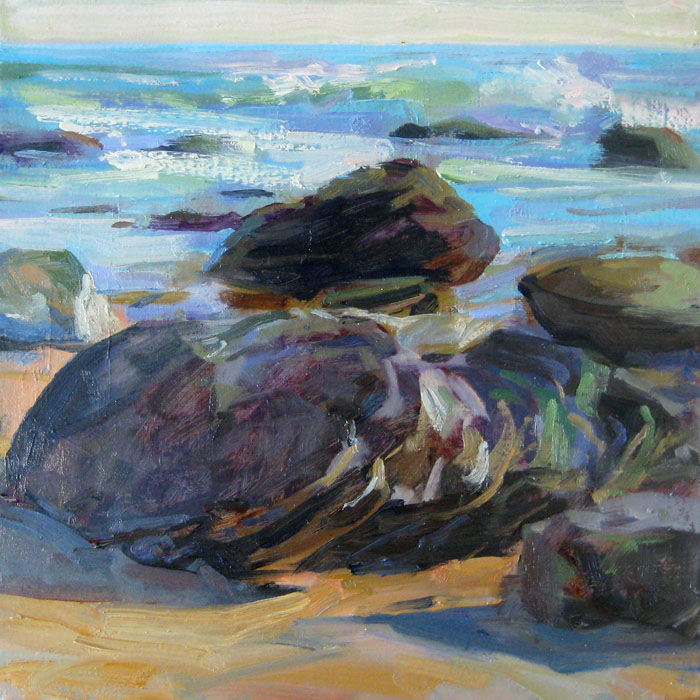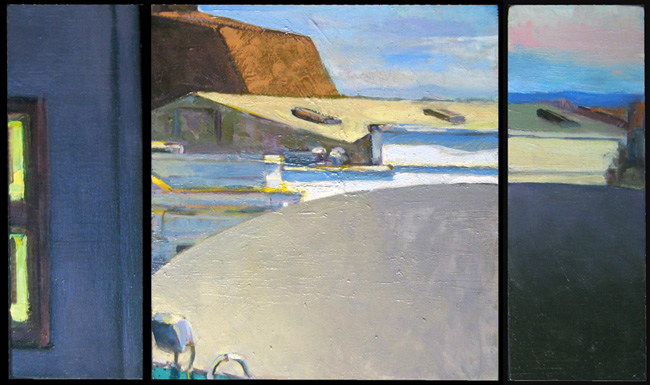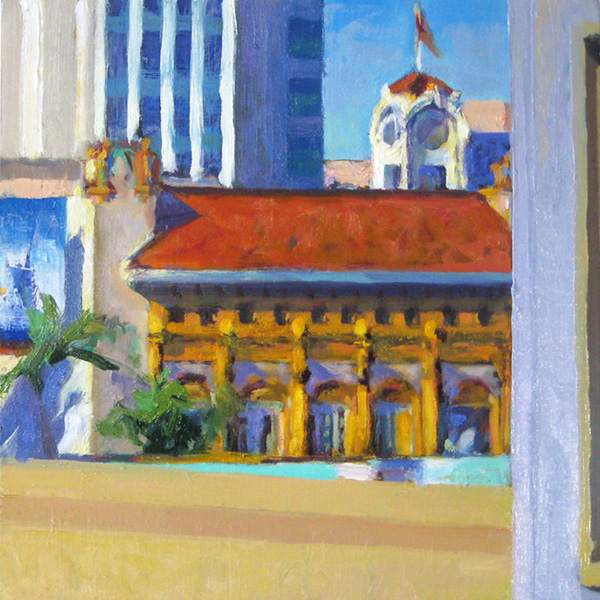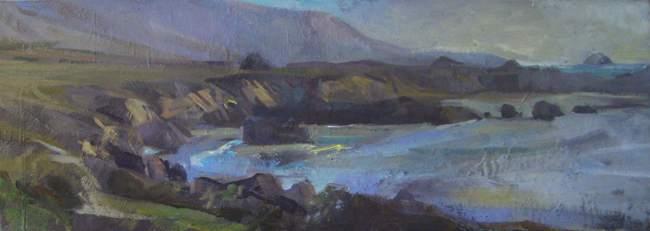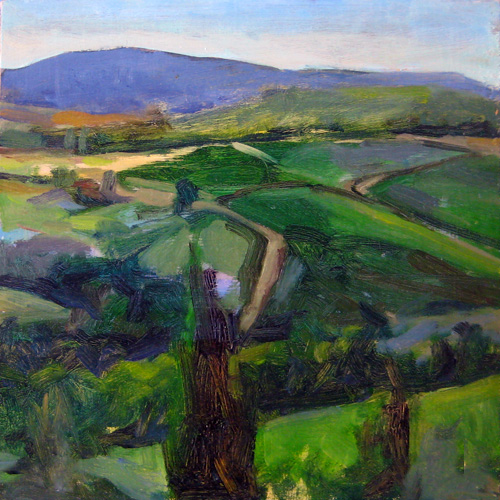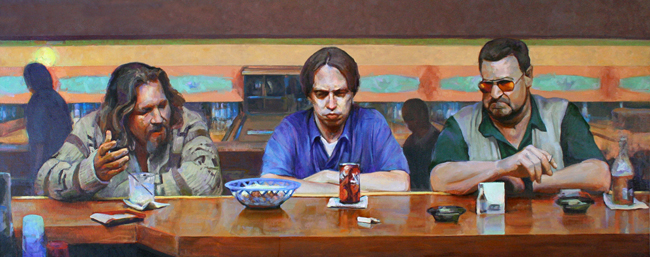
Supper at Emmaus (After Caravaggio) • Joe Forkan (in progress) oil on linen 96″x 38″
Unlike most of the paintings in The Lebowski Cycle, I started The Supper at Emmaus using an indirect painting method, and worked up the image as a grisaille.
In the early stages of this series, I made a trip to Europe specifically to look at narrative paintings and Baroque era masterworks. I spent a lot of time with Caravaggio’s Supper at Emmaus (which is currently on loan to The Art Institute of Chicago). Many of the master works that I am referencing used indirect painting methods, and I was interested in employing this method to develop a strong play of light and shadow in this painting.

Process images from The Supper At Emmaus • joe Forkan 2006-2009
I worked up the main figures, the still life and the basic shapes of the background entirely in low contrast, high value gray and white, and then developed the figures from there with glazing and scumbling. However, I wanted the space to be defined more by color relationships than by the value relationships that tend to define space in Caravaggio’s work, so the space was built with more contemporary notions about color in mind. The ideas of Hans Hoffmann, Josef Albers and Albert Munsell, tend to inform my use of color in general (although painting from nature is always the best teacher).
The painting underwent considerable changes, especially in the background and foreground areas, with thicker applications of more opaque paint, although many areas are still handled more indirectly.
There is really no way to accurately identify in sketches and studies how color relationships will actually read once they are translated onto a large scale painting, so there was a lot of trial and error in the process of defining the space of the room in relation to the figures.
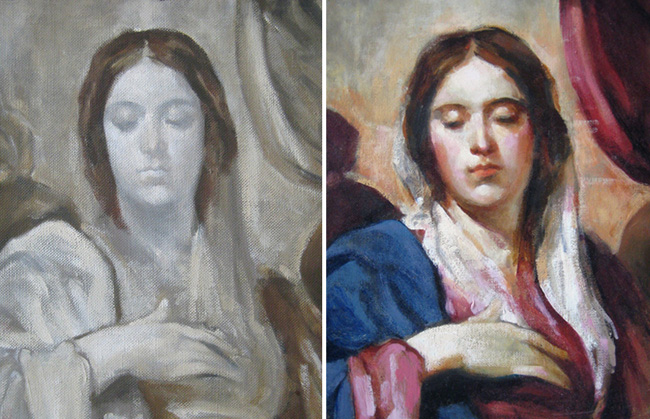
Two studies exploring direct and indirect methods based on The Coronation of the Virgin by Diego Velazquez • Joe Forkan 2001
It’s can be difficult to talk about painting techniques in isolation from the ideas that one is using the techniques to express.
At play in the paintings are the differing sources, stories and visual references, seriousness and humor, and a wide range of possible readings. These are subtle relationships that direct the evolution of the paintings, but everything is expressed through the language of painting, and the language of painting is also part of what I’m trying to talk about.
So the work grows based on the dynamics between these elements, rather than a march towards some premeditated notion of what the finished painting should look like. Sometimes that means the process ends abruptly, or months of work are obliterated and begun again. It may not be the most efficient system, but this approach does let the paintings evolve beyond their initial conception. I have seen painters who plan their work, and then basically start at one corner and work their way across the canvas, and once they hit the far edge, they’re finished. I’ve never had much success painting that way.

Detail from The Supper at Emmaus • Joe Forkan 2009
My early teachers always stressed working paintings up all at once. The idea was that everything is in play on the canvas, and each mark affects all the relationships throughout the entire piece.
At that time Neo-Expressionism was all the rage, so rough drawing, emotional color, and violent mark-making were de rigueur. The studio was more boxing ring than laboratory or atelier. Painting was to be done on the balls of one’s feet. It was a struggle and an endurance test and the smell of modernist, two-fisted Action Painting still hung heavily in the air.
Even Hans Hofmann’s famous “push/pull” theory, concerning “the visual tension between forces and counter-forces” in a painting sounds more like a wrestling move than an art theory. Push. Pull. Attack the painting. Charge the image. Lots of action verbs.
I like this physical approach to painting, but at the time, much of it was directed towards the production of very aggressive political paintings, which I wasn’t much interested in making. (I was a political cartoonist at the time, so I already had a place to grind that particular ax).
Many of those formal strategies have remained a part of my process, and I do think that this all-over approach can lend coherence and life to a painting, (and the studio still feels like a boxing ring some days).
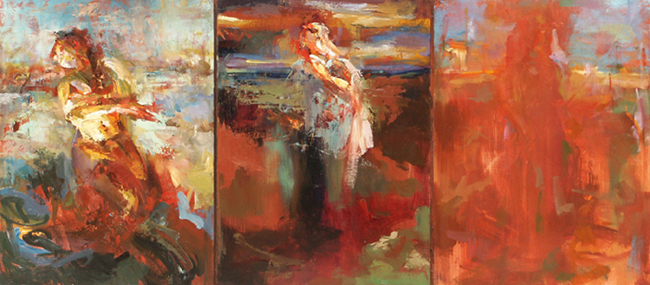
An example of a more physical approach to painting from 2002 • Arcadia Joe Forkan
It’s probably not the easiest way to engage a body of work referencing old master paintings with believable figures in believable space, and I did dial it back a bit for this particular painting. There were still some dramatic changes in the process, however.
Part of the appeal of this work for me is trying to build compelling images out of the collision of so many ideas and methods that seem at such cross purposes.
I love this Chuck Close quote about painting from an interview he did with Charlie Rose:
“Painting is one of the most magical of mediums, maybe in my mind, maybe the most, because it transcends its physical reality. You know, its just colored dirt, on some cloth, wrapped around some wood strips. It makes space where there is no space, and it conjures up images from life experience. You know, paintings can make you cry, and its just colored dirt. If you think about sculpture, sculpture occupies a real space, you can move around it, and relate to it the same way you relate to this table …but a painting is a magical window, and it’s just the most fun to play around with and build these things out of colored dirt”.

